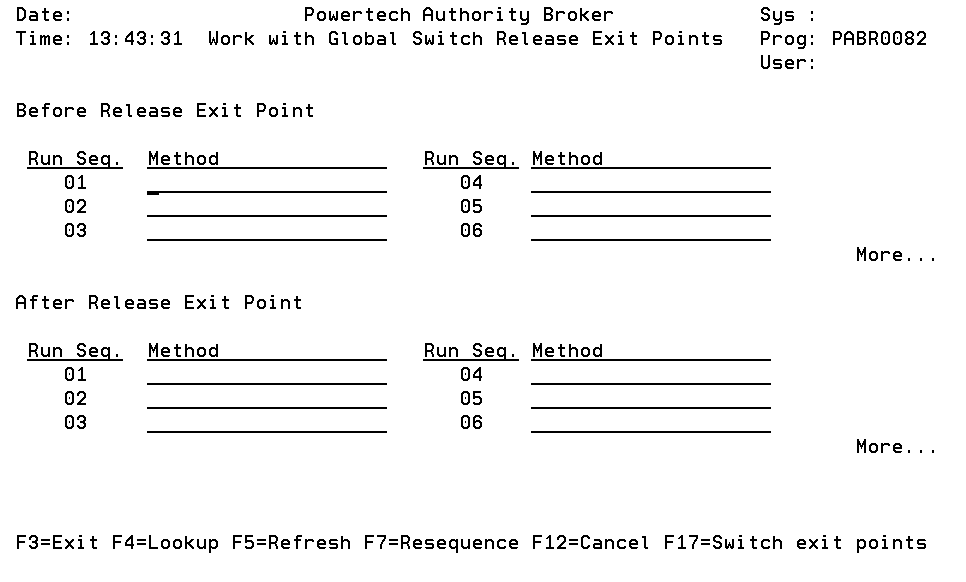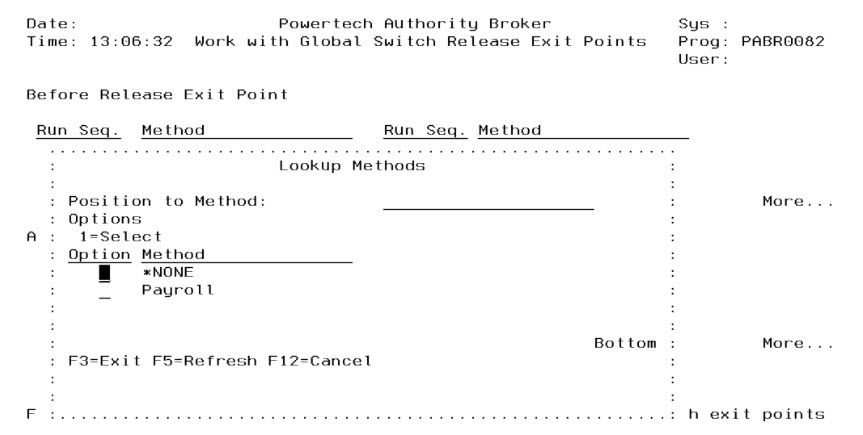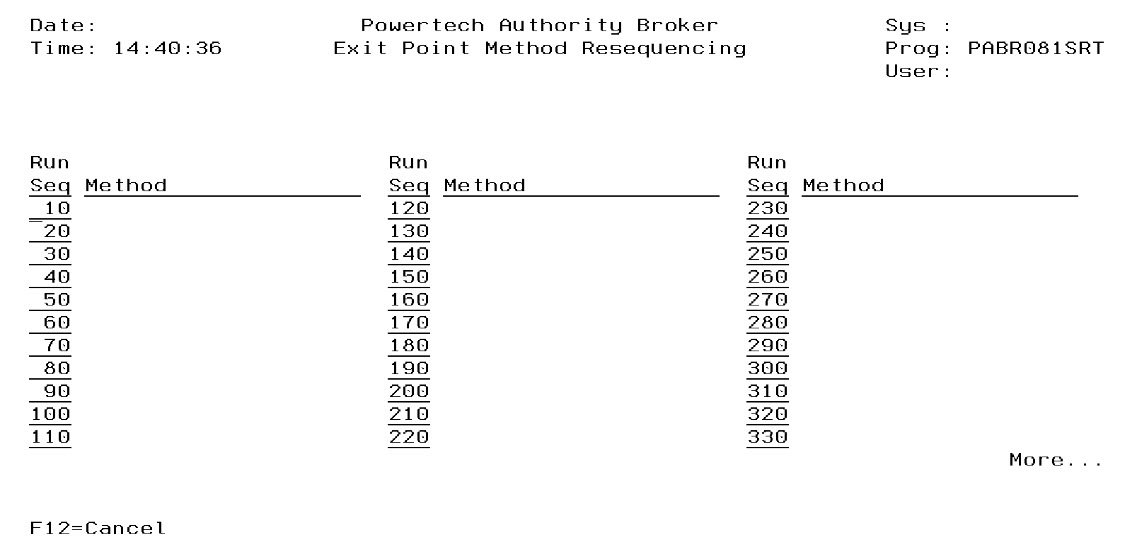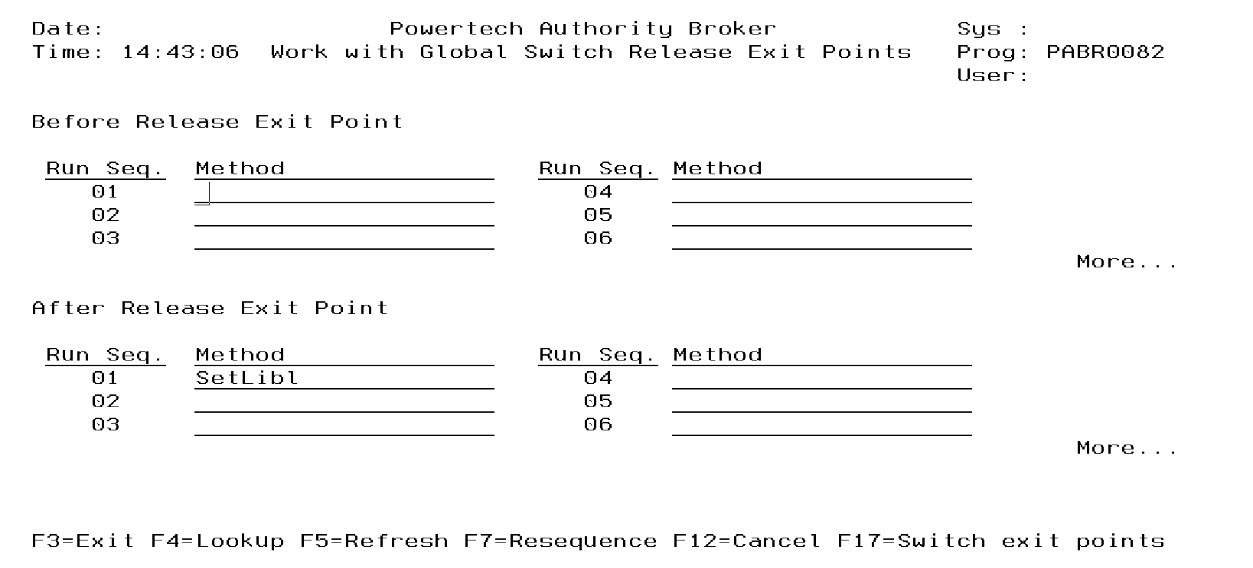Work with Global Switch Release Exit Points screen
The Work with Global Release Exit Points screen is used to list, add, and remove global release exit points. The screen is divided into two sections: Before Release Exit Point methods and After Release Exit Point methods.
Before Release Exit Point methods are the exit point methods to be executed before a profile switch is actually released. These exit point methods are used to perform functions not provided by Powertech. Reinstating a job's library list is an example of how these exit point methods can be used. A maximum of 50 exit point methods can be defined.
After Release Exit Point methods are the exit point methods to be executed after a profile release has occurred. These exit point methods are used to perform functions not provided by Powertech. Sending tracking entries to a Help system is an example of how these exit point methods can be utilized. A maximum of 50 exit point methods can be defined.
How to Get There
From the Work with Product Exits Menu, choose option 11.
Options
Before Release Exit Point
Before Release Exit Point methods are the exit point methods to be executed before a profile switch is actually released. These exit point methods are used to perform functions not provided by Powertech.
Rules for assigning Before Release Exit Point methods:
Maximum entries: A maximum of 50 exit point methods can be defined. Each exit point method must be assigned a run sequence number between 1 and 50. Duplicate exit point methods are allowed.
Run Sequence: Each exit point method must be assigned a run sequence between 1 and 50.
Exit point method: Each exit point method must be defined before it can be entered. Pressing F4 while the cursor is on an exit point method will pop up the Exit Point Method Lookup window.
More for Before Release
More exit point method entry lines are available.
After Release Exit Points
After Release Exit Point methods are the exit point methods to be executed after a profile switch has occurred. These exit point methods are used to perform functions not provided by Powertech.
Rules for assigning After Switch Exit Point methods:
Maximum entries: A maximum of 50 exit point methods can be defined. Each exit point method must be assigned a run sequence number between 1 and 50. Duplicate exit point methods are allowed.
Run Sequence: Each exit point method must be assigned a run sequence between 1 and 50.
Exit point method: Each exit point method must be defined before it can be entered. Pressing F4 while the cursor is on an exit point method will pop up the Exit Point Method Lookup window.
More for After Release
More exit point method entry lines are available.
Required Parameter Group
|
Parameter |
How Used |
Data Type |
Sequence |
Notes |
|---|---|---|---|---|
|
Exit point name |
Input |
CHAR(20) |
1 |
The name of the exit point being executed. PTG_AB_BEFORERELEASE is the exit point name used for the Before switch exit point. PTG_AB_AFTERRELEASE is the exit point name used for the After switch exit point. |
|
Exit point format name |
Input |
CHAR(10) |
2 |
The format name of the exit point being executed. ABRL0100 = Global Before switch release. ABRL0200 = Switch pair specific Before switch release. ABAR0100 = Global After switch release. ABAR0200 = Switch pair specific After switch release. |
|
System user |
Input |
CHAR(10) |
3 |
The name of the user profile that switched to the application/resource ID. |
|
Application/Resource ID |
Input |
CHAR(10) |
4 |
The name of the user profile the system user is switching to. |
|
Reserved |
|
CHAR(128) |
5 |
Reserved. |
Optional Parameter Group
|
Parameter |
How Used |
Data Type |
Sequence |
Notes |
|---|---|---|---|---|
|
Client IP address |
Input |
CHAR(15) |
6 |
The client IP address returned from IBM’s QUSRJOBI API in format JOBI0600. |
|
System name |
Input |
CHAR(8) |
7 |
The name of the system the profile switch took place on. This is the same name as shows in the “Current system name” parameter of IBM command DSPNETA. |
|
Job environment type |
Input |
CHAR(1) |
8 |
The job’s environment type. 0 – A value - lf “0” indicates the job that performed the profile switch was running in batch mode. 1 – A value - lf “1” indicates the job that performed the profile switch was running in interactive mode. |
|
FireCall switch |
Input |
CHAR(1) |
9 |
Specifies if the profile switch was for a FireCall. Y = FireCall switch N = Not a FireCall switch. |
|
Switch amount of time |
Input |
CHAR(6) |
10 |
The number of minutes the switch is allowed to operate. |
|
Call ticket number |
Input |
CHAR(20) |
11 |
The number of minutes the switch is allowed to operate. |
|
Interested Party list |
Input |
Array of CHAR(10) |
12 |
A list of parties interested in the profile switch. A maximum of 100 interested parties will be supplied. |
|
Number of array elements |
Input |
INT(10,0) |
13 |
The number of entries in the Interested Party list. |
Function Keys
F3 (Exit): End the current task and returns to the display from which the task was started. If changes have not been accepted prior to F3 being pressed, they will be lost.
F4 (Lookup): Displays the 'Lookup Methods' window and provides lookup capabilities when the cursor is on an exit point method.
F5 (Refresh): Restores the display to the values found in the database. Any changes will be lost.
F7 (Resequence): Provides list resequencing capabilities (shown below). The cursor must be on an editable field.
F12 (Cancel): Returns to the previous menu or display. If changes have not been accepted prior to F12 being pressed, they will be lost.
F17 (Switch exit points): Displays the Switch exit points screen. Entries must be correct before the Switch exit points screen will redisplay.



